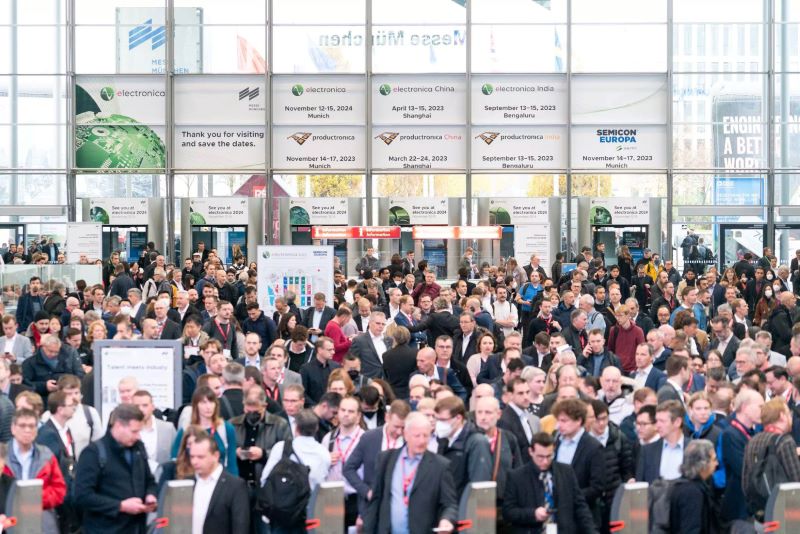Sixty years ago. electronica became the first trade fair in Germany to be devoted solely to electronic components and since 1964 it has highlighted innovations in the international electronics industry and provide a complete market overview of the industry’s latest products, technologies and solutions every two years.
In 1964, after the US, the then Federal Republic of Germany was the most important producer of electronic products in the western world at that time, so hosting a trade fair seemed an obvious decision and was encouraged by a number of international companies.
The first edition in Munich in October 1964 proved to be a great success with over 400 companies from 16 countries exhibiting and 14,000 trade visitors flocked to the old Munich exhibition grounds over the eight days of the fair. One of the highlights of that year’s show was a model of the Syncom III communications satellite, which was lost for five days after being transported from the US to Munich before being discovered in a corner of Munich Airport just in time for the start of the trade fair.
By the time of the second show in 1966, which had already attracted almost 800 exhibitors and 22,000 trade visitors, electronica had established its position as the world’s leading electronics exhibition.
Since then, it has experienced steady growth and shown countless innovations such as the microchip which it showed to the world for the first time. A number of technological milestones have shaped the trade fair from the introduction of microprocessors in the 1970s, to the development of mobile communication in the 1980s and 1990s, and the rapid advances in digitalization in the 2000s with the spread of wireless Internet.

Above: This year's show is expected to be the biggest in electronica's 60-year history
Electronica has continued to evolve and 2024 will be the first time that all 18 exhibition halls will have been filled – with a little help from SEMICON Europa which is occupied by two halls.
Two big themes at this year’s show include smart energy solutions and automation.
Electronics is a key factor in the energy transition and development of smart energy solutions and so smart energy plays a decisive role in shaping a sustainable energy future and includes smart grids and smart meters as well as innovation in power electronics. This year’s show and conference will highlight how these technologies contribute to the efficient production, distribution and use of electricity, hence transforming the entire value chain in the energy industry.
According to a report by MarketsandMarkets, the global market for smart energy is expected to grow from $170bn in 2022 to reach over $280bn by 2027 so against that backdrop electronica will provide technology companies and industry experts with a platform to present their innovations, to network, and to discuss the latest developments and trends.
Beyond the exhibition floor the Power Electronics Forum in Hall A5 will look at the entire spectrum of power electronics. Hall A4 will be all about innovations in transformers, power supplies, power supply units and batteries. In Halls B4, B5, C3, C4 and C5, numerous exhibitors will be presenting their latest products and solutions relating to semiconductors, while embedded systems can be found in Hall B4.
Automation is at the heart of modern industries and is driving forward the digital transformation in almost all sectors. So, electronica 2024 will present the latest developments in two of its key areas, sensor technology and connectivity.
Leading companies and experts will showcase the key trends and technologies paving the way to the All Electric Society promoting both energy efficiency and sustainability.
On show will be the latest developments in programmable logic controllers (PLC), which play a decisive role in automating production processes and enable companies to respond flexibly to changes in demand or technology. Sensors are the backbone of modern automation solutions and record and process data that is essential for controlling and monitoring machines and systems. At electronica 2024, companies such as AMSYS, Omron, STMicroelectronics and Würth will be presenting the latest sensor technologies.
Also on display will be the latest connectivity solutions which are crucial for seamlessly integrating automation systems. Industrial Ethernet enables real-time communication and end-to-end networking right down to field level, while Single Pair Ethernet (SPE) offers compact solutions that transmit energy as well as data, thereby increasing efficiency in industrial applications.
By integrating intelligent systems and energy-efficient processes, it is possible to optimise energy consumption and promote sustainable technologies.
At this year’s electronica visitors can look forward to a host of innovations from well-known exhibitors that will shape the future of automation, including for example Delta, Murata, Toshiba or Vishay.
The Embedded Platforms Forum on November 12 and 13, and the Industrial Control Forum on November 14 (Hall C5), will be indispensable meeting place for all players in the industry, from developers and product managers to device and system manufacturers.
Here’s to electronica 2024 and the next sixty years.













